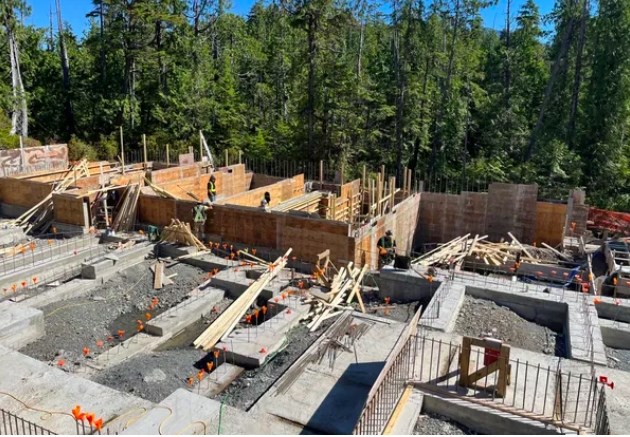Small Island community might have answers to Kamloops, Okanagan housing crisis

The tiny community of Tofino – population 2,500 – is in the middle of building 86 affordable housing units through a municipally owned corporation.
It’s a rare example in B.C. of a municipality not only setting up an arms-length corporation but supporting its business community by building housing that workers can afford to rent.
“The ingredients are simple yet they’re hard to swallow,” Ian Scott, interim executive director of Tofino Housing Corporation, told iNFOnews.ca. “You need leadership, you need effort and you need money.”
And time.
Tofino is, in many ways, no different than Kelowna and other Okanagan communities where tourism is a large part of their economies.
That Vancouver Island community, like the Okanagan, has a shortage of housing that workers in the tourism industry, who are often low-paid or work part time, can afford.
In 2005 Tofino incorporated the Tofino Housing Corporation to “carry on the business of providing attainable and affordable housing for employees and residents within the District of Tofino.”
That didn’t work out all that well so the corporation was dissolved in 2012 but revived in 2017 because of an increased demand for affordable housing.
It has two parcels of land that the District has owned for many years for the new housing and has put money into a fund to get the project going.
The corporation partnered with the Vancouver-based Catalyst Community Developments Society. That’s a not-for-profit real estate developer that builds and operates affordable rental housing.
Last year, 14 homes were completed in Tofino and have now been rented out. Another 72 are under construction now.
READ MORE: Inflation driving people out of their homes, on to Kelowna streets
The District of Tofino contributed about $1 million to the project, both in land value and cash.
The source of that funding is a key to its success.
Two houses were donated by a developer and sold at below market value.
Other developers contributed cash through “amenity bonuses” where they paid extra to increase density or achieve zoning changes.
A big player is the revenue from the Municipal and Regional District Tax. That’s a 3% tax on tourist accommodation that contributes between $100,000 and $275,000 a year to the fund.
The District of Tofino did not directly use taxpayers’ money for the housing corporation but did waive development cost charges and it provides some administrative support.
“There is nothing stopping Kelowna from hiring a consultant like me and working quite closely with the mayor and CAO to get something done,” Scott said. “I bet if they put that focus to it, even with limited resources, they’d have more success. Making it a priority is step one and that has to be at a leadership level.”
Kelowna has a similar room tax but that revenue goes to Tourism Kelowna to promote the area.
“They have all the power in the world to devote some of that money to housing,” Scott said. “If they started to do that, they might have more success with housing and, I suspect, a lot of tourists will still come to Kelowna.”
In 2019, the tax generated $2.8 million in Kelowna.
But, for Kelowna at least, changing where that money goes is not an option in the short term. The city has a five-year contract with Tourism Kelowna that was just renewed.
That tax is also about 60% of Tourism Kelowna’s budget.
There are other ways to put money into housing and the City of Kelowna does have a number of mechanisms for supporting not-for-profit and other types of more affordable housing.
But setting up a housing corporation isn’t on anyone’s radar and was not part of campaign platforms in the Oct. 15 election.
“There’s a lot of good reasons why it’s hard,” Scott said. “If today, this council said we want to put our money into building housing, the chances of that ribbon cutting happening during their current term are slim. It just takes that long.”
But the need is there.
Scott noted that public housing used to be 10% of the new home market but governments have, for decades, dropped that funding and it’s at an estimated 1-2% now.
READ MORE: Decades of downloading on cities led to homelessness in Kamloops, Okanagan today: report
“I think we need to get to 20% plus of public housing for our communities to be healthy and sustainable,” Scott said. “To get there, that would suggest investing, on a yearly basis – probably for a decade or more – probably 10 to 20 times what we are spending now.”
While Tofino's focus is on providing worker housing there will also be options for people on fixed incomes like disability and seniors pensions.
As in the Okanagan, housing for lower paid workers is in short supply or non-existent.
“We have a long way to go before we create any kind of sustainability on the housing front,” Scott said. “I suspect that experience has happened earlier in Tofino than it has in Kelowna, just as it has in resorts like Banff and Canmore and Whistler and other places like that.”
For more on the Tofino Housing Corporation, go here.
To contact a reporter for this story, email Rob Munro or call 250-808-0143 or email the editor. You can also submit photos, videos or news tips to the newsroom and be entered to win a monthly prize draw.
We welcome your comments and opinions on our stories but play nice. We won't censor or delete comments unless they contain off-topic statements or links, unnecessary vulgarity, false facts, spam or obviously fake profiles. If you have any concerns about what you see in comments, email the editor in the link above.



